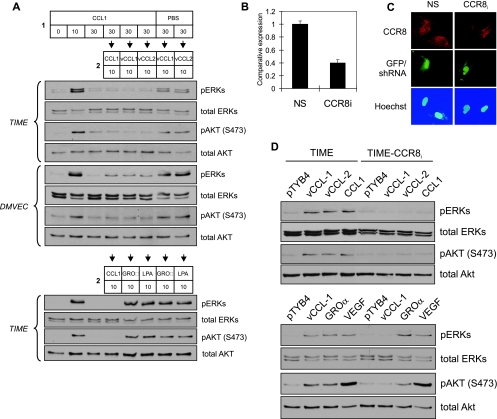FIG. 2.
CCR8 usage by viral chemokines. (A) Receptor desensitization to investigate the utilization of CCR8 by vCCL-1 and vCCL-2 in endothelial cells. Recombinant CCL1 (250 ng/ml) was applied to TIME or DMVEC cultures for 30 min (step 1); parallel cultures were stimulated with PBS to provide a negative control. Then, optimal signaling doses (250 ng/ml) of vCCL-1 and vCCL-2, or non-CCR8 agonist controls, were applied for a further 10 min (steps 2), before cell harvest. Cell lysates were analyzed by Western blotting for detection of ERK and AKT activation (phosphorylation). Cells pretreated with CCL1, but not with PBS, were resistant to stimulation by the v-chemokines. Ten-minute stimulation with CCL1 in the pretreatment step (1) gave the expected signaling responses, which diminished to baseline by 30 min (beginning of step 2). CCL1 pretreatment did not affect signaling by CCR8-independent GROα (200 ng/ml) or lysophosphatidic acid (5 μM), demonstrating the specificity of the desensitization effect. (B to D) CCR8 knockdown to determine CCR8 utilization. TIME cells were infected to near 100% efficiency (determined by GFP fluorescence) with lentivirus (GFP+)-shRNA vectors specifying either CCR8 mRNA-directed (CCR8i) or nonsilencing (NS, control) sequences. Cultures were analyzed by qRT-PCR (B) or with a derived cell line (E2) by CCR8-specific IFA (C) for the expression of CCR8 mRNA and protein, respectively. For the latter, lentivirus-infected cells were mixed with uninfected TIME cells to provide a means of comparison; GFP-positive (lentivirus-infected) cells showed markedly decreased expression of CCR8 (red) relative to GFP/lentivirus-negative cells. (D) Signal transduction by the v-chemokines and CCL1 (250 ng/ml) in TIME-CCR8i(E2) cells was greatly diminished relative to that in TIME cells (top). Application of GROα (200 ng/ml) or VEGF (10 ng/ml) to the cultures resulted in equivalent signal transduction in TIME and TIME-CCR8i(E2) cells but reduced signaling in TIME-CCR8i(E2) cells by CCR8 agonist CCL1, demonstrating the specificity of the CCR8-shRNA effect (bottom).

